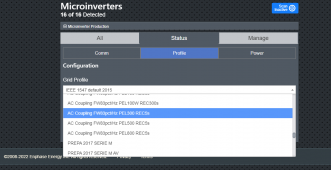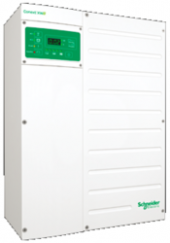The power finally came back on at 4:34 am. The noise from our neighbors A/C coming on woke me up, and I can also see it in the battery summary in the XW. The battery only ran down to 52.2 volts, so it was still above the "Recharge Volts", but it went directly into charging anyways. And because there was no solar happening at 4 am, the PLC was not even looking to make adjustments, it came on at 45 amps of charge current. Just a few minutes later, I manually set it down to just 10 amps to start charging slow until the sun comes up. The battery came up a little more than 1 volt to 53.3 by 8:30 as the solar is now making more than the house is using again.
I made a few notes about thing I need to change in my PLC code, and I now know I need to update my XW. At what version did they fix the odd frequency issue? Getting stuck at 57.6 Hz makes no sense at all. When there is no power at AC1 or AC2 it should run on an internal clock at the correct grid frequency of 60 Hz (or 50 Hz in other regions). It should only vary from that to either track an AC input that is off frequency a little, or when it frequency shifts to cause a grid tie inverter to reduce output. In the 9 hours that the frequency was running low, two of my clocks fell 32 minutes behind. They are both digital displays. My cheapo alarm clock in my bedroom, and the clock on the kitchen range. Our other 2 plug in digital clocks held decent time as always, and so did the microwave oven. While the microwave was on the backup power, I did not try cooking in it with the 57.6 Hz power.
Now that the solar panels have enough light to power them up, I also changed them back to Cal Rule 21 grid profile, but when I went to the pull down list, there were a bunch of new profiles. Check out this screen grab.

The one I have highlighted sounds nice. "AC Coupling FW83pct/Hz PEL300 REC5s"
We all know what AC Coupling means, but the rest sounds interesting.
I may be wrong, but I think I decoded that correctly.
The FW is Frequency Watt. 83pct/Hz, I think means it will reduce it's output by 83 percent for an increase in frequency of 1 Hz. Nice to actually see a number on it.
Then PEL300 I think means "Power Export Limit". For that to work, I bet it requires the consumption side current transformers at the main. Then it will limit to just 300 watts of export from the solar.
And finally "REC5s" I think means "Reconnect after just 5 seconds" when it sees good grid again.
That all sounds great for an off grid setup, but here in So Cal, I might have some problems with the fast reconnect while I am on grid. While the XW is Rule 21 compliant, and it won't export for the full 5 minutes after a good grid, it does connect the loads to the grid much sooner when it qualifies that the power is ok. And the Enphase with this grid profile might then start exporting in just 5 seconds. If the XW battery is low, it should be commanded to use that power to charge the batteries, so it still should not be "exporting", but this still depends on our external controllers to make this happen. My current code has at least a 5 second delay, and could easily be over 7 seconds if it misses the moment the current comes on. So once it sees power export, it will send the command to start charging. Allowing the Enphase to export only up to 300 watts is good, and should work with my setup, but any lower would be trouble. My current code has to see export exceed 150 watts to increase the charge current. Each time that happens, the Enphase production meter would see it is exporting less than 300 and ramp up the microinverter output. Then my PLC will see it over 150 watts again, raise the charge current. Then Enphase will see less than 300 export and ramp up again. It should go to where the inverters are not curtailing any power. My charge current steps are about 80 watts, so I need a window at least that big. I currently have the PLC seek a 100 watt window, from 50 to 150 watts. This looks like it will work nicely, with my current seek window. It might only need a minor tweak to keep it stable. I might move it to seek 0 to 100 watts, to give a little more room for the Enphase to see while I am using the extra power for charging. Then, once the battery is full, it would then export limit at 300 watts beyond what the house is using. Under my current NEM 2.0 agreement, I don't want that 300 watt limit though. If I still have good sun, and my battery is full, I want the credit for the power, but if NEM 3.0 penalizes us for export, this could be a good option.




